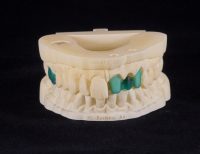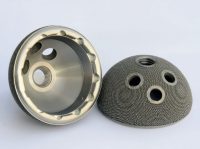From form studies to production-ready, functional components, the medtech applications for 3-D printed parts are growing rapidly. Parts created in 3-D design software can be quoted almost instantly by a myriad of 3-D printing shops. With a growing number of vendors offering online and automated quote apps, the time required to iterate on the design for manufacturability compresses significantly. Lead times for parts are being reduced—most parts can be made and delivered within 24 hours. Components can then be tested in the end-use environment, revealing possible improvements to be made, while speaking to a final manufacturing process.
The use of such parts is growing across industry, with their application to medtech products becoming more widely accepted. The human body is uniquely suited to these processes and parts; many are taking note of this and creating novel solutions to a plethora of medical needs.

Applications
The human body is a dynamic, highly variable, and organically shaped form. Integrating products with the human body has always been a challenge, as soft tissue and high range of allowable motion are difficult to accommodate. Many medical device products are created as simplified geometric shapes. This is partly due to the ease of control offered by the mathematics governing these designs. Traditional processes involved in creating these shapes—subtractive methods, such as machining and fabricating—also favor simplified geometric shapes, which are faster and more reliable within these processes to fabricate and verify through measurement.
3-D printing has shaken up these established methods of design. We are now able to create contoured surfaces to a great level of precision and repeatable accuracy. In relatively small quantities, this can be accomplished much faster than traditional methods (e.g. injection molding). Faced with how to model shapes that fit with the human body, the 3-D modeling software industry is catching up. We can employ upgrades to existing 3-D modeling software, as well as use 3-D scanning technologies to capture the human form.
Biocompatibility with living tissues, whether on or inside the body, is a major concern for medical device designers and producers. This not only relates to materials used in products but the processes used to create the shapes of parts and methods used to assemble them. Process cleanliness is a major component of medical device development. Examples of when traditional methods of fabrication cause issues include the coolant ingress into material—take the machining of parts via CNC, for example, using a mill or lathe. Since most additive processes (FDM, SLA, SLS/DMLS, jet-based) require only the virgin material and a heat source, control over the cleanliness of the final product can be finely tuned; however, the cleanliness of these processes is still under development, as their application to parts used in medical applications is only just beginning.
Wearable (on the body)
Design and fabrication processes in 3-D printing have come far in recent years, giving opportunity to many applications, especially in the medical device field. Biocompatible materials—such as acrylonitrile-butadiene-styrene (ABS), polycarbonate (PC), and polylactic acid (PLA)—are widely used in 3-D printers. They lend themselves well to such uses as wearable monitors and prosthetics.
Wearable monitors and devices are on trend and seeing growth currently, and as a way to iterate forms, 3-D printing is key. This decreases time to market through increasing feedback from users, testing the device’s comfort and feel, with the ability to change form and implement changes on prototypes.
Prosthetics are designed to conform to and replace a body part, generally a portion of a limb. Models of the area to interface can be created through 3-D scanning methods, and a prosthetic matched to this profile using 3-D modeling software. Leveraging this relationship, the final part can conform perfectly to an individual’s physical profile. 3-D printing of the part also allows for contoured surfaces to be easily produced, matching them to the mating portion of the patient. As traditional processes favor repeatable setups, this is a key area for growth. Due to the increase in accessibility to 3-D printing technology, this application is being taken up across the globe to deal with lack of access to medical care and has provided many individuals with the opportunity to receive prosthetics at a lower cost than previously available options.
Implantable (in the body)

Bone replacements, custom splints, and sub-dermal drug delivery devices—3-D printed applications in the body are growing at an ever-increasing rate. With implantable materials such as PEEK and titanium and the process to create patient-specific conforming shapes, surgeons and clinicians are seeking companies that provide custom fabrication of these parts and systems. Bone replacement techniques can benefit from the sintering process of creating titanium using direct metal laser sintering (DMLS), and specialty ceramic blends using selective laser sintering (SLS). This is due in part to the capability of the process to produce final parts that are porous, as bones will integrate better with grow-in interfaces. This has been well documented in literature. Custom splints for specific applications is fast growing, as surgeons have many requirements for the shape and attachment requirements for different bone structures and shapes. Opposed to the traditional “pin” method, this will open many opportunities to explore integrated solutions to allow the body to repair bones and internal trauma.
As 3-D printing can employ several jetted materials simultaneously, multi-substance prints can combine to create a composite final product. This could contain multiple components, such as a drug within a polymeric matrix. This is especially useful when considering the timed release of drugs in patients, as the dosage can be finely tuned due to the ingress of fluid or biodegradation of the material. Patient compliance to taking drugs at set times is therefore not a factor, as with traditional dosage methods like pills.
The design solutions created by 3-D printing are numerous and diverse. The capabilities of customized printed parts with fast design cycles lends itself to medical devices greatly. Whether on or in the body, many advantages can be gleaned from these processes. The potential of 3-D printing in medical device development are limitless –future years will provide even more exciting applications for these and novel technologies to come.
Common Processes
What 3-D printing processes are available and what are their relative merits? Several techniques have been commercialized on large scales. With a blossoming of material choices and refining of processes in recent years, 3-D printing has spread its potential and is now used across the entire design process in medical device development. From concept modeling in early stage development to production, 3-D printed parts are becoming indispensable. The flexibility of 3-D printing in medtech comes down to several aspects: speed of the design cycle, cleanliness of the process, resolution of the finished part, and the variety of materials and processes available.
Continue to page 2 below to read about each manufacturing method.






